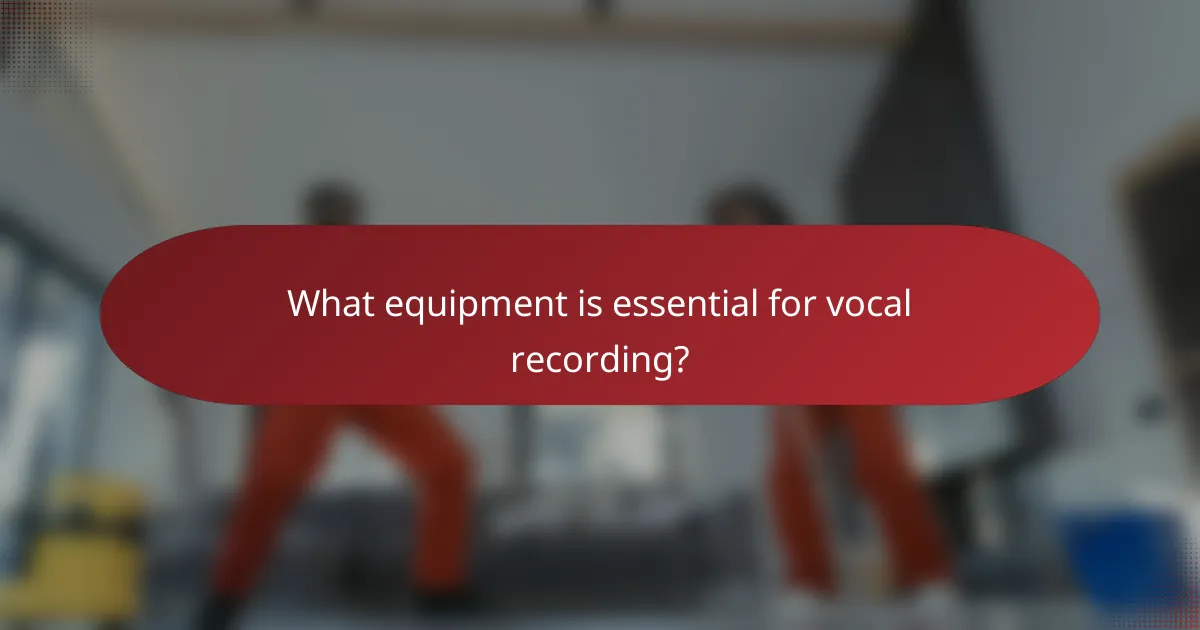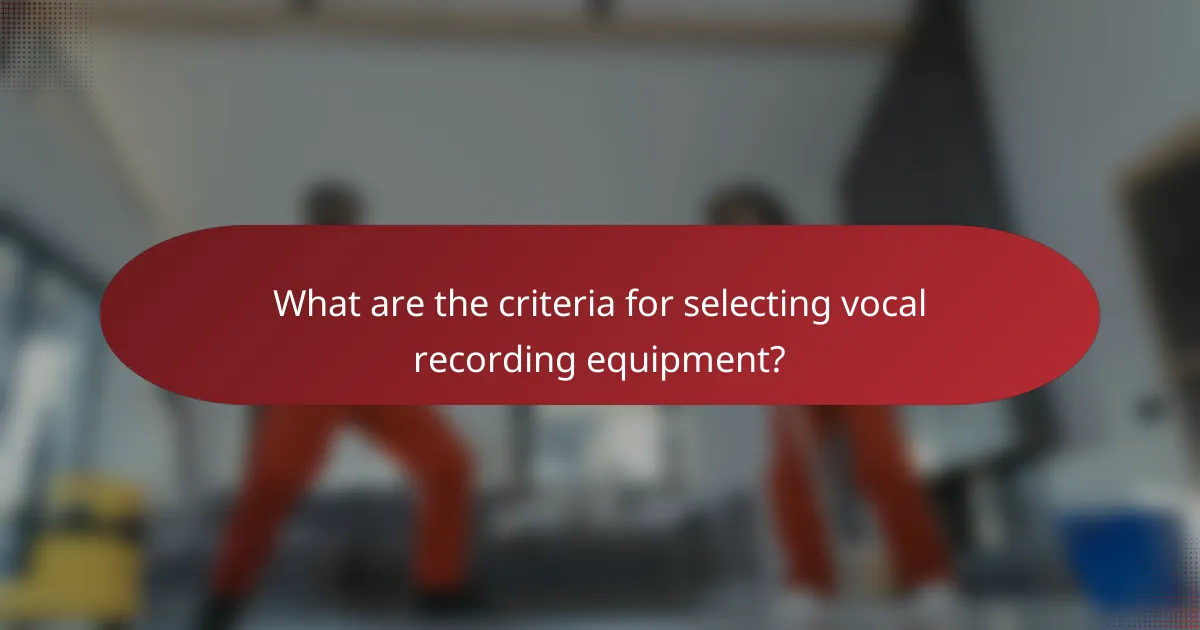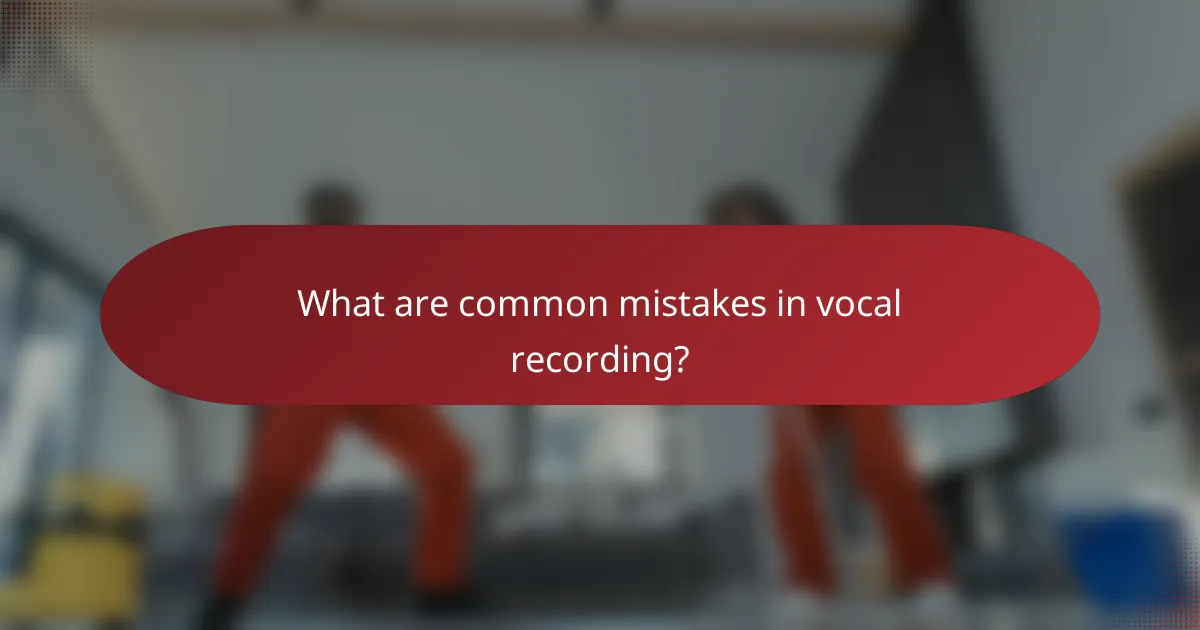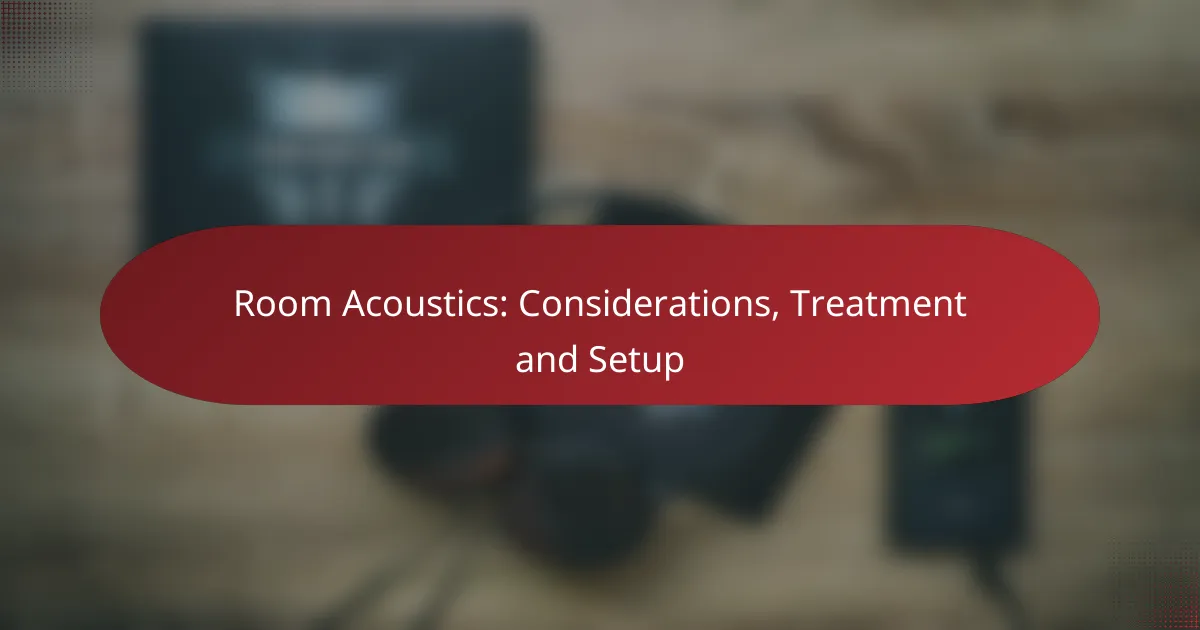Vocal recording is an art that combines technique, equipment, and environment to achieve high-quality sound. By focusing on methods such as proper microphone placement and vocal warm-ups, along with utilizing essential gear like high-quality microphones and audio interfaces, one can capture clear and professional vocals. Additionally, creating an optimal recording environment through soundproofing and acoustic treatment is crucial for minimizing noise and enhancing sound quality.

What are the best vocal recording techniques?
The best vocal recording techniques focus on achieving clarity, warmth, and presence in the final audio. Key methods include proper microphone placement, vocal warm-ups, layering, dynamic range control, and the use of pop filters.
Microphone placement
Microphone placement significantly influences the quality of vocal recordings. Position the microphone about 6 to 12 inches from the singer’s mouth to capture a balanced sound while minimizing unwanted noise. Experiment with angles and distances to find the sweet spot that enhances vocal clarity.
Consider the type of microphone being used; condenser mics often require closer placement for optimal warmth, while dynamic mics can be placed slightly further away without losing quality. Always test different placements to see what works best for the specific voice and recording environment.
Vocal warm-up exercises
Vocal warm-up exercises prepare the voice for recording, enhancing performance and reducing strain. Simple exercises like lip trills, humming, and scales can help loosen the vocal cords and improve breath control. Spend at least 10 to 15 minutes warming up before recording sessions.
Incorporate both physical and vocal warm-ups, such as stretching the neck and shoulders, to promote relaxation. This practice can lead to more expressive and controlled vocal performances, ultimately improving the recording quality.
Layering and harmonizing
Layering and harmonizing vocals can add depth and richness to recordings. Record multiple takes of the same line, slightly varying the delivery for a fuller sound. This technique is especially effective in genres like pop and rock, where vocal harmonies enhance the overall texture.
When harmonizing, aim for intervals that complement the main vocal line, typically thirds or fifths. Use panning to place different vocal layers in the stereo field, creating a more immersive listening experience.
Dynamic range control
Dynamic range control is essential for maintaining a consistent vocal level throughout a recording. Use compression to even out volume fluctuations, ensuring that softer passages are audible while louder sections remain clear. Aim for a moderate compression ratio to preserve the natural dynamics of the voice.
Be cautious not to over-compress, as this can lead to a lifeless sound. A good rule of thumb is to set the threshold so that the compressor engages only on the louder peaks, allowing the vocal performance to breathe while still achieving a polished result.
Use of pop filters
Pop filters are crucial for reducing plosive sounds that can distort recordings. Place a pop filter about 2 to 4 inches in front of the microphone to diffuse bursts of air from consonants like “p” and “b.” This simple tool can significantly improve the clarity of vocal recordings.
When selecting a pop filter, consider materials such as nylon or metal, which can affect sound quality differently. Ensure the filter is securely mounted and positioned correctly to maximize its effectiveness without obstructing the vocalist’s performance.

What equipment is essential for vocal recording?
Essential equipment for vocal recording includes a high-quality microphone, an audio interface, studio headphones, and a digital audio workstation (DAW). Each component plays a critical role in capturing and producing clear, professional-sounding vocals.
Microphones: Shure SM7B
The Shure SM7B is a dynamic microphone renowned for its versatility and ability to capture rich vocal tones. It features a cardioid pickup pattern that minimizes background noise, making it ideal for untreated rooms.
When using the SM7B, consider pairing it with a preamp to boost the signal, as it requires more gain than many other microphones. This mic is a favorite among professionals for its durability and sound quality.
Audio interfaces: Focusrite Scarlett 2i2
The Focusrite Scarlett 2i2 is a popular audio interface that offers high-quality preamps and low latency, making it suitable for vocal recording. It connects easily to computers via USB and supports both XLR and 1/4-inch inputs.
When choosing an audio interface, look for features like phantom power for condenser mics and multiple input options if you plan to record instruments alongside vocals. The Scarlett 2i2 is user-friendly, making it a great choice for beginners and experienced users alike.
Headphones: Audio-Technica ATH-M50x
The Audio-Technica ATH-M50x headphones are favored for their excellent sound isolation and accurate audio reproduction. They are closed-back headphones, which help prevent sound leakage during recording sessions.
When selecting headphones for vocal recording, prioritize comfort and sound quality. The ATH-M50x offers a balanced sound profile, making it easier to monitor vocals without distortion.
Digital Audio Workstations: Ableton Live
Ableton Live is a versatile digital audio workstation (DAW) that is widely used for recording and editing vocals. Its intuitive interface and powerful features make it suitable for both live performances and studio recordings.
When working with a DAW, familiarize yourself with its recording, editing, and mixing capabilities. Ableton Live supports a range of plugins and virtual instruments, allowing for creative vocal production. Consider exploring its session view for flexible arrangement options.

How to create an ideal vocal recording environment?
Creating an ideal vocal recording environment involves minimizing unwanted noise and optimizing sound quality. This can be achieved through effective soundproofing, acoustic treatment, and selecting the right room dimensions.
Soundproofing techniques
Soundproofing is essential to prevent external noise from interfering with vocal recordings. Common techniques include sealing gaps in doors and windows, using heavy curtains, and adding soundproofing materials like mass-loaded vinyl or acoustic panels. These methods help create a quieter space, which is crucial for capturing clear vocals.
Consider using soundproofing foam or insulation in walls to enhance the effectiveness of your setup. Additionally, placing rugs or carpets on the floor can help absorb sound and reduce echoes.
Acoustic treatment options
Acoustic treatment focuses on improving sound quality within the recording space. This can be accomplished by adding diffusers, absorbers, and bass traps to control reflections and standing waves. Proper placement of these materials can significantly enhance vocal clarity and reduce muddiness in recordings.
For example, placing absorptive panels at first reflection points on walls can minimize unwanted echoes. Bass traps in corners can help manage low-frequency buildup, ensuring a balanced sound.
Optimal room dimensions
The dimensions of your recording room can greatly influence sound quality. Ideally, a rectangular room with a length-to-width ratio of 1.5:1 or 1:1.5 helps minimize standing waves and resonance issues. Avoid square rooms, as they tend to create problematic acoustics.
When selecting a room, consider ceiling height as well; higher ceilings can improve sound dispersion. A space with dimensions around 10 to 15 feet in length and width, with a ceiling height of at least 8 feet, is often suitable for vocal recording.

What are the criteria for selecting vocal recording equipment?
When selecting vocal recording equipment, consider factors such as sound quality, budget, compatibility with existing gear, and brand reputation. These criteria help ensure that your setup meets your recording needs while providing reliable performance.
Budget considerations
Your budget is a crucial factor when choosing vocal recording equipment. Prices can vary widely, from entry-level microphones costing around $100 to professional-grade models that can exceed $1,000. Determine how much you are willing to invest and prioritize features that align with your recording goals.
Keep in mind that while higher-priced equipment often offers better sound quality and durability, there are many affordable options that can still deliver excellent results. Look for gear that provides the best value for your budget.
Compatibility with existing gear
Ensure that any new vocal recording equipment is compatible with your current setup. This includes checking connections, such as XLR or USB, and ensuring that your audio interface or mixer can support the new gear. Incompatible equipment can lead to additional costs and complications.
Before purchasing, review the specifications of your existing equipment and compare them with the new items. This will help you avoid potential issues and streamline your recording process.
Brand reputation and reviews
Brand reputation plays a significant role in the reliability and performance of vocal recording equipment. Research well-known brands that are recognized for their quality and durability in the audio industry. Reading user reviews can provide insights into the real-world performance of the equipment.
Look for brands that have a history of producing reliable gear and check for reviews on platforms like audio forums or retailer websites. This will help you make an informed decision and avoid brands with a track record of poor performance or customer service.

What are common mistakes in vocal recording?
Common mistakes in vocal recording include poor microphone placement, inadequate room acoustics, and neglecting to monitor levels. These issues can lead to subpar audio quality, making it essential to address them during the recording process.
Poor microphone placement
Poor microphone placement can significantly affect the quality of vocal recordings. Positioning the microphone too far away may result in a weak signal, while placing it too close can cause distortion and unwanted plosives. A good rule of thumb is to keep the microphone about 6 to 12 inches from the vocalist’s mouth, adjusting based on the singer’s volume and style.
Inadequate room acoustics
Inadequate room acoustics can lead to echo and unwanted background noise in vocal recordings. To mitigate this, choose a quiet space with soft furnishings that absorb sound, or use acoustic panels to dampen reflections. Avoid recording in large, empty rooms, as they often produce undesirable reverb.
Neglecting to monitor levels
Neglecting to monitor levels can result in recordings that are either too quiet or clipped. It’s crucial to keep an eye on the recording levels throughout the session, aiming for a peak level around -6 dB to -3 dB. Regularly checking levels helps ensure a balanced sound and reduces the need for extensive editing later.










